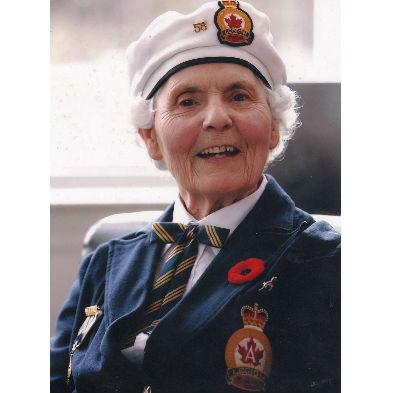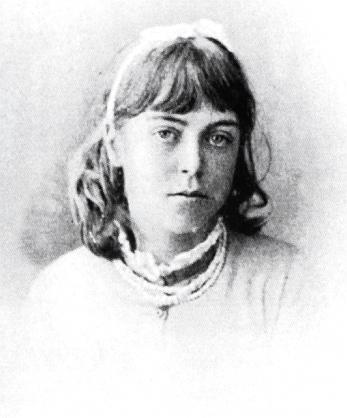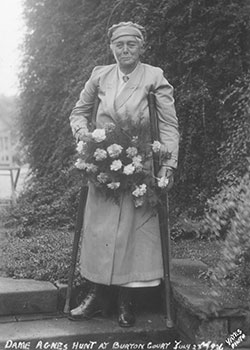Agnes Gwendoline Hunt
Contributors
- Chelsey Bunch, Student - Utah Valley University - Orem, Utah
Editors/Reviewers
- Sean N. Bennett, RN, MSN - Associate Professor - Utah Valley University

Biography
Agnes Hunt was born 31 December 1867 at Boreatton Park, Baschurch, Shorpshire, England (cited in The Robert Jones and Agnes Hunt Orthopedic and District Hospital, 2009). Daughter to Roland Hunt and Marianne Humfrey, she was raised in a strict Victorian childhood (Bishop, 1980, p.11). Her parents, being very authoritarian, believed in the saying spare the rod, spoil the child. Her mother especially detested children, and all eleven in the family were taught to take their punishments in silence. Complaining was not encouraged in the Victorian days. This engrained lesson is what caused hesitation for Agnes in 1877, at the age of ten, when she got a bad blister on the heel of her foot. Not wanting to cause a fuss she endured in silence until delirium, general blood poisoning, and a high fever set in. She had developed septicemia and infective arthritis of the hip joint. Agnes later wrote, “My apprenticeship to crippledom had begun, and also the great education of pain” (Hunt, 1980, p. 22). Her mother, in spite of bad parenting, did one good thing for Agnes at this hard time in her life. She would not allow Agnes to pity herself, or think of herself as different from anyone else. Nor were the other children allowed to treat her any different than they would each other. This, combined with Agnes’s character, had her being pulled in a bath chair behind a donkey, and out playing ice hockey on the frozen pond in a home made sled, all within a year.

Another year later, in December of 1879, her father died along with much of their once vast wealth. In 1882, the family moved to their mother’s home in Leicestershire, Kibworth Hall. They did not stay long though because one day Agnes’s mother went to a town meeting and heard a man speak about Queensland, Australia. He mentioned the breeding of Angora goats and the many benefits that came with it. That was all it took. Once Marianne made up her mind, there was no stopping her. On 11 March 1884, dragging seven of her eleven children with her, she set off by ship, arriving in Brisbane Australia, looking to be an Angora goat breeder.
After no Angora goats were to be found, a purchase of 50 acres, a failed attempt at a chicken farm, and many more memorable adventures, Marianne moved back to England. Agnes lingered, living in Tasmania with her brother Tom.
A few years later, in 1887, they both moved back to England. Agnes had just turned 20 and she soon enrolled as a nursing student at the Royal Alexandra Hospital in Rhyl, North Wales and the West London Hospital in Hammersmith, England (Mosofi, 2005 p. 148).
Contributions
Nursing was a hard profession in those days, draining both physically and mentally. Nurses often worked long hours and lived in austere conditions – eating only bread, cheese, and beer for dinner each night. One of the founders and teachers of the Royal Alexandra Hospital, Miss Graham, showed another side to nursing in her teachings - The heart of nursing. “No nurse is worth her salt if she has not the joy of life within her and the power of sharing it with her patients” (cited in Mostofi, 2005 p. 148). It is no surprise, with a founder like Miss Graham, that the Royal Alexandra Hospital was among the first, if not the very first, to practice open air and happiness as two principles to bettering the lives of the crippled. Agnes took this lesson to heart, receiving the queen’s badge and brassard award in 1891; she went to work for the next nine years treating from normal district nurse encounters to typhoid and smallpox epidemics.
In 1900 two things happened that Agnes was not expecting. First she received a call from her mother, informing her daughter that she intended on living with her (Mostofi, 2005 p. 148). Agnes couldn’t believe it. Only a few short years ago she had become a nurse, and now she was being forced to give it up to care for her elderly mother. Devastated with this fact, Agnes started thinking of alternatives. Not alternatives to where her mother could live, but alternatives to what she could do with herself. That’s when it happened; the second thing she was not expecting. If Agnes needed to care for her mother, she would do the same for others. The idea of caring for crippled children, something she had personal experience with, became her mission. A few years earlier, when Agnes was working in Salop Infirmary (Great British Life, 2010) she met Emily Selina Goodford, born 1856 in Eton, Buckinghamshire, England (Locklock, 2008). Agnes told Emily of her plans in orthopedics, and together they worked to make this become a reality. In October they opened Baschurch Home and received their first patients, four boys and four girls. Baschurch was a pioneer to orthopedic hospitals, preventive treatments, and teaching the disabled about their new lives as cripples.
In 1903, Agnes’s hip was becoming infected again and she made a trip to Liverpool to see an orthopedic surgeon. She met with Robert Jones, born 23 June, 1857, in Rhyl, North Wales, a meeting that would have a very big impact on the world of orthopedics (Great British Life, 2010). Agnes and Robert shared a common interest for treating children. Hearing about what Agnes was doing with Baschurch Home, Robert wanted to help. He became the honorary surgeon there, visiting once a month, doing surgery’s on the kitchen table. Agnes and Robert’s friendship continued to grow, along with the number of patients at Baschurch Home. It was obvious that changes would need to be implemented, and soon. There were people sleeping all over the house and in stables and sheds outside. In 1919, a facility became available, Park Hall Military Hospital in Gobowen, Shorpshire, England. This facility became the new Baschurch Home, which was later renamed the Shropshire Orthopedic Hospital in 1921.
The achievements of the hospital were tremendous. Children would come anywhere from a few months to a few years for treatment, returning home in better condition. This accomplishment alone was not enough for Robert and Agnes. In 1927 they both agreed that instead of just treating these crippled children, they needed teach them to live on their own. Agnes wrote to County Councils offering opportunities to help the crippled support themselves. It was a huge success. People were signing up before the hospital had room to accommodate them. It appeared further remodeling was in store. Agnes dreamed of a pristine hospital for the new remodeling, and John Menzies, a secretary-superintendent at the hospital, made Agnes’s dream hospital become real. The extra space allowed for the children to be schooled from their beds, since they could be at the hospital from months to years. Agnes also founded Derwin College in 1927. A place where the children could go learn a trade. It still thrives today.
Legacy & Memory
Robert was growing older, and was beginning to have trouble with his health. Agnes started to write an autobiography, to lift his spirits, sharing with him her crazy adventures of growing up and dealing with her mother. It brought him much joy and laughter until he passed away in 1933, when the hospital was renamed, again, in his memory; Robert Jones & Agnes Hunt Orthopedic Hospital. It is now home to surgeons from all over the world, still providing orthopedic care.
Dame Agnes Hunt was a woman who’s contributions to the study of orthopedics and voluntary service of clinics changed England and the world for the better. She finished her autobiography, Reminiscences, known just as a volume at that time, in 1936. In 1938, the title was changed to This is My Life, and was published by a company in London (Bishop, 2008 p. 9). Before the title was changed, a newspaper wrote about her book on 22 February 1936, that described the true genius of Agnes’s character.

Hunt, is unusually disappointing, but for the unusual reason that there Is not enough of It. Thrice as much as she tells would still be far too little. Herself a cripple from childhood, Dame Agnes Hunt tells how, out of nothing, she built a great orthopedic hospital. She made her bricks without either straw or clay, and treats her achievement as a huge joke. Her story is a crushing retort to the man-made gibe that women have no sense of humor. Her courage, endurance, disappointments, and anxieties are cloaked under an unfailing spirit of fun, which she uses also as a shield against the handicap of her own physical infirmity. In spirit and In letter she lives up to the dictum of one of the first matrons under whom she worked-"that no nurse was worth her salt If she had not the joy of life in her and the power of sharing it with her patients.” Not even her astonishing mother could restrain Dame Agnes Hunt from adopting nursing as a career, and her own incorrigible levity fails to hide her almost religious devotion to her chosen profession. The story of the establishment of her hospital and of her selfless devotion to her ideal is written as a comedy in which all the tears will not arise from laughter. This is a small book, but worth its weight in gold! (Bricks without clay, 1936, p. 9)
She was an amazing woman who named the essential qualities of a nurse as “common sense, gentleness, kindliness, and the power of giving hope and joy to those who are suffering” (cited in Mostofi, 2005). Recognized by many, she received the Royal Red Cross award in 1918, was created Dame Commander of the British Empire in 1926, founded the Derwen Cripples’ Training College in 1927, and a physiotherapy school in 1952. She died 24 July 1948 at the age of 80 (cited in The Robert Jones and Agnes Hunt Orthopedic and District Hospital, 2009). Her memorial in Gobowen states: “Reared in suffering thou shalt know how to solace others’ woe. The reward of pain doth lie in the gift of sympathy” (Wikipedia, 2001).
Further Readings
- [http://yba.llgc.org.uk/en/s-JONE-ROB-1857.html Biography of Sir Robert Jones] Welsh biography online. (2009). Jones, Sir Robert, Bart.
- [http://en.wikipedia.org/wiki/Victorian_era Victorian Era] Wikipedia. (2010, November 3). Victorian era.
- [http://www.nlm.nih.gov/medlineplus/ency/article/001355.htm Septicemia] Medline plus. (2010). Septicemia.
- [http://www.rjah.nhs.uk/media/pdf/historical/fctsht10fire.pdf Fire of 1948] The Robert jones and agnes hunt orthopedic and district hospital. (2009). Historical Fact Sheet No 10.
- http://www.rjah.nhs.uk/ Robert Jones and Agnes Hunt Orthopedic and Distract Hospital] Robert jones and agnes hunt orthopedic and distract hospital. (2005).
References
- Bishop, Morris. (1980). This is My Life. Forward, 9 – 15. New York: Arno Press Inc.
- Bricks without clay. (1936, February 22). The Argus, p. 9. Retrieved from http://nla.gov.au/nla.news-article11884724
- Great British Life. (2010). The orthopedic RJAH, oswestry. Retrieved from http://shropshire.greatbritishlife.co.uk/article/rjahoswestry-shropshireorthopaedic-9397/
- Hunt, Agnes. G. (1980). This is My Life. New York: Arno Press Inc.
- Lovelock Family History Web Site. (2008, April 23). Lovelocks from the 1891 Census Returns for Buckinghamshire. Retrieved from http://perso.numericable.fr/~lovjames/family-history/lovelock/documents/1891bucks.html
- Mostofi, Aeye d. B. (Ed.). (2005). Dame Agnes Hunt 1967-1947. In Who’s who in orthopedics (pp. 147 – 152). London: Springer-Verlag
- The Robert Jones and Agnes Hunt Orthopedic and District Hospital. (2009,January). Historical fact sheet no 2. Retrieved from http://www.rjah.nhs.uk/media/pdf/historical/fctsht2agneshunt.pdf
- Wikipedia. (2001, January 15). Agnes Hunt. Retrieved from http://en.wikipedia.org/wiki/Agnes_Hunt
- Wikipedia. (2001, January 15). Agnes Hunt. Retrieved from http://en.wikipedia.org/wiki/Agnes_Hunt
Pictures
- [http://www3.shropshire-cc.gov.uk/roots/images/med_f03a.jpg Young Agnes Hunt]
- [http://www.rjah.nhs.uk/media/images/agnes_hunt.jpg Dame Agnes Hunt]
- [http://hharp.org/static/images/jones-hunt.jpg Agnes Hunt & Robert Jones]
- [http://www.rjah.nhs.uk/media/images/robert_jones.gif Sir Robert Jones]
- [http://www.latemeetings.com/images/Venue/08919.jpg Boreatton Park]
- [http://www3.shropshire-cc.gov.uk/roots/images/med_o14a.jpg Hunt Family at Boreatton Park]
- [http://grumpystumpy.com/images/England/shropshire/Shrewsbury/008-Shrewsbury---Royal-Salop-Infirmary---PM-1933.jpg Salop Infirmary]
- [http://farm5.static.flickr.com/4142/4959722137_43c5b50815_z.jpg Royal Alexandra Hospital]
- [http://hharp.org/static/images/baschurch-home.jpg Baschurch Home]
- [http://www3.shropshire-cc.gov.uk/roots/images/med_f15a.jpg First 8 children at Baschurch Home]
- [http://www3.shropshire-cc.gov.uk/roots/images/med_f16a.jpg New Open Wards, Park Hall Military Hospital, 1919]
- [http://www3.shropshire-cc.gov.uk/roots/images/med_f23a.jpg Memorial to Emily Goodford, 1920]
- [http://www3.shropshire-cc.gov.uk/roots/images/med_f11a.jpg Children having school lessons from their beds]
- [http://www3.shropshire-cc.gov.uk/roots/images/med_o16a.jpg Physiotherapy School, 1952]
- [http://www3.shropshire-cc.gov.uk/roots/images/med_f14a.jpg Fire of 1948]
- [http://www3.shropshire-cc.gov.uk/roots/images/med_f12a.jpg Derwin Cripples’ Training College: Carpenter Workshop]
- [http://www.lonelyplanet.com/maps/europe/england/map_of_england.jpg Map of England]